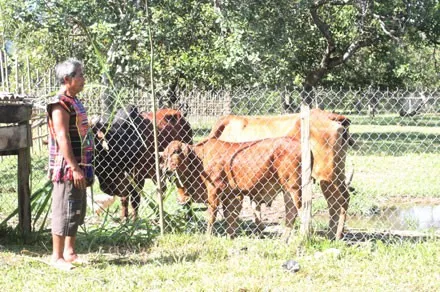For S’Tiêng people, lives improving bit by bit


|
| Seventy-year–old Điểu K’Mốt from the S’Tiêng ethnic group in Lâm Đồng Province feeds his cows.— Photo laodong.com.vn |
LÂM ĐỒNG — For hundreds of years, S’Tiêng ethnic people in the Central Highlands Province of Lâm Đồng lived in forest in the border area among Lâm Đồng, Bình Phước and Đồng Nai, now better known as Cát Tiên National Park.
They used to live in the forest and rely on the forest. No roads, no schools and no healthcare centres. However, things have changed much thanks to improved public awareness and infrastructure, Lao động (Labour) newspaper reported.
S’Tiêng people living on the bank of Đồng Nai River are now residents of Phước Cát 2 Commune, Cát Tiên District, Lâm Đồng Province.
They live in Hamlet 3 and Hamlet 4 - the most remote and disadvantaged area of the commune.
In 2004, boat was the only way to reach Hamlet 3, with vessels only arriving every two days.
In 2005, a dirt path was built to link the hamlet to the centre of the commune – Phước Ái Hamlet.
The road stretches dozens of kilometers through forest, Nông Văn Thụ, Phước Cát 2 Commune’s Party Committee Secretary told Lao động.
Thụ said that work to make the dirt path a concrete road was completed last year..
“Youth Union members helped build the road. They went to the forest, cleared bushes to make paths and widened the path,” Thụ said.
“When opening a new road through the Cát Tiên National Park, they had to minimise negative impacts that harm the forest ecosystem,” Thụ said.
Once the road to the Hamlet 3 was opened, things changed a lot, he added.
In the last decade, S’Tiêng people started growing cashew, tea and raising cows or goats.
They replaced makeshift bamboo houses with cement ones.
Thụ said that besides farming, S’Tiêng people in Hamlet 3 have improved their incomes by protecting the forest.
Seventy-year-old Điểu K’Mốt, said that a few decades ago, S’Tiếng people lived like trees in the forest, seeking food day by day.
However, they had changed a lot, he said, adding that they took the advice of local officials, soldiers and forest rangers.
They farmed, sent children to school or ran businesses, Điểu K’Mốt said. His family now raises dozens of cows, buffaloes and goats and has a garden of a few hectares.
Điểu K’TRang, 57 years old, said they were poor because they did not have the chance to go to school.
In 2012, he donated about 3,000 sq.m of land to build a school. A new school with three classrooms was opened in 2013 for 27 children to attend from first grade to fifth grade.
Since 2014, children aged from three to six could go to preschool as local teachers volunteered to turn their housing into a classroom.
Điểu K’Dố, 35 years old, said that he followed Điểu K’Trang and donated almost 1,000 sq.m of land to build a healthcare centre in Hamlet 3.
“I saw many sick elderly did not have medicine or pregnant women had to travel tens of kilometres to reach the district hospital,” he said.
Hồ Văn Phát, a local health officer said working in the hamlet’s new health centre made him happy.
“Previously, there was little medicine and medical equipment available in the hamlet’s healthcare centre. Most patients were transferred to district’s hospital,” he said.
“Now, we have better facilities, offering healthcare for not only residents in Hamlet 3 but also people from other hamlets,” Phát said.
Chairman of Phước Cát 2 Commune People’s Committee said that the local residents, particularly S’Tiêng people in remote disadvantaged areas, now wanted electricity.
Once power lines reached Hamlet 3 and Hamlet 4, locals’ living conditions would improve further, he said. — VNS
Tags:





